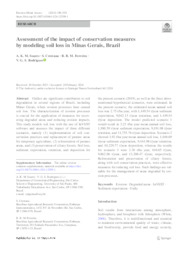Assessment of the impact of conservation measures by modeling soil loss in Minas Gerais, Brazil.
Assessment of the impact of conservation measures by modeling soil loss in Minas Gerais, Brazil.
Autoria: SOARES, A. K. M.; CRESTANA, S.; FERREIRA, R. R. M.; RODRIGUES, V. G. S.
Resumo: ABSTRACT: Gullies are significant contributors to soil degradation in several regions of Brazil, including Minas Gerais, where erosion processes have caused soil loss. The characterization of erosion processes is crucial for the application of measures for recovering degraded areas and reducing erosion impacts. This study models soil loss with the use of InVEST software and assesses the impact of three different scenarios, namely (1) implementation of soil conservation practices and replacement of pasture areas for temporary agriculture, (2) reforestation of pasture areas, and (3) preservation of ciliary forests. Soil loss, sediment exportation, retention, and deposition for the present scenario (2019), as well as the three aforementioned hypothetical scenarios, were estimated. In the present scenario, the estimated mean annual soil loss was 2.75 t/ha year, with 1,449.54 t/year sediment exportation, 9,042.13 t/year retention, and 1,449.54 t/year deposition. The model predicted scenario 1 would result in 2.23 t/ha year mean annual soil loss, 1,300.59 t/year sediment exportation, 9,191.08 t/year retention, and 11,755.76 t/year deposition. Scenario 2 showed 1.92 t/ha year mean annual soil loss, 1,046.69 t/year sediment exportation, 9,444.98 t/year retention, and 10,229.77 t/year deposition, whereas the results for scenario 3 were 2.36 t/ha year, 616.65 t/year, 9,862.06 t/year, and 13,206.47 t/year, respectively. Reforestation and preservation of ciliary forests, along with soil conservation practices, were effective measures for reducing soil loss. Such findings are valuable for the management of areas degraded by erosion processes.
Ano de publicação: 2024
Tipo de publicação: Artigo de periódico
Unidade: Embrapa Instrumentação
Palavras-chave: Degraded areas, Erosion, Gully, InVEST, Sediment exportation
Observações
1 - Por padrão são exibidas publicações dos últimos 20 anos. Para encontrar publicações mais antigas, configure o filtro ano de publicação, colocando o ano a partir do qual você deseja encontrar publicações. O filtro está na coluna da esquerda na busca acima.
2 - Para ler algumas publicações da Embrapa (apenas as que estão em formato ePub), é necessário ter, no celular ou computador, um desses softwares gratuitos. Sistemas Android: Google Play Livros; IOS: iBooks; Windows e Linux: software Calibre.
Acesse outras publicações
Acesse a Base de Dados da Pesquisa Agropecuária (BDPA) para consultar o acervo completo das bibliotecas da Embrapa.

